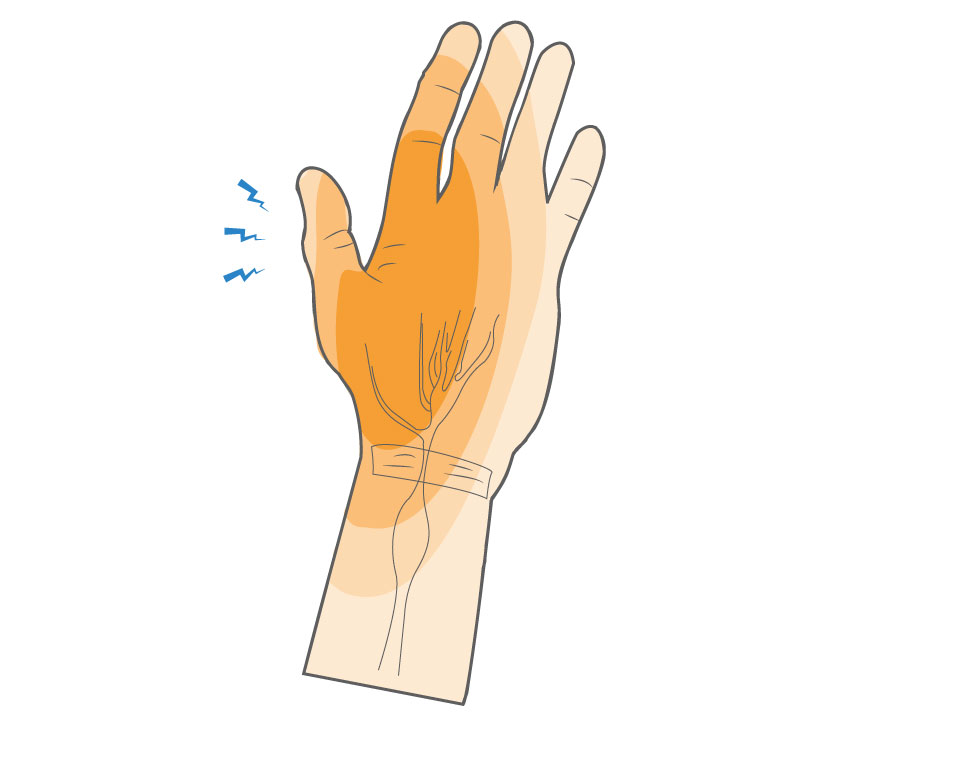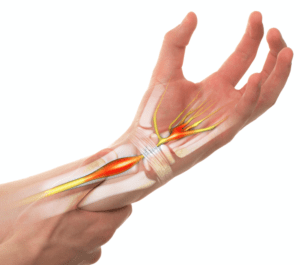The median nerve is a major nerve that allows parts of the hand to have feeling and movement. It enters the hand through a narrow channel, called the carpal tunnel. Carpal tunnel syndrome occurs when excessive pressure is placed on the median nerve. This common condition can cause pain, numbness, and a tingling sensation in the hand and arm. Left untreated, it can lead to permanent nerve damage.
Carpal Tunnel Syndrome Causes, Symptoms & Treatment
The median nerve is a major nerve that allows parts of the hand to have feeling and movement. It enters the hand through a narrow channel, called the carpal tunnel. Carpal tunnel syndrome occurs when excessive pressure is placed on the median nerve. This common condition can cause pain, numbness, and a tingling sensation in the hand and arm. Left untreated, it can lead to permanent nerve damage.
Overview
Overview

What causes Carpal Tunnel Syndrome?
Often the cause of carpal tunnel syndrome is unknown, or carpal tunnel syndrome is caused by a combination of factors. Increased pressure on the nerve can result from swelling of the lining of the flexor tendons, the long fibrous cords that connect the forearm muscles to the finger bones. Athletes are at risk if they play sports that require keeping the wrist in a fixed or flexed position for a prolonged period of time, or from activities that repetitively flex the wrist.
Carpal tunnel syndrome is most common in these sports:
• Tennis
• Racketball
• Squash
• Cycling

Symptoms
People with carpal tunnel syndrome typically experience pain, numbness, and a tingling sensation in the hand. Other common symptoms include:
• Pain, numbness, or tingling that wakes you up from sleep
• Symptoms come on when holding your wrist fixed or flexing your wrist, such as when driving or holding a newspaper, racket, or handlebar
• Weakness in the hands
• Pain that extends to the elbow
• Permanent loss of sensation in the affected fingers
When to see a doctor
If you have symptoms of carpal tunnel syndrome that persist or get worse, make an appointment to see your doctor. Left untreated, carpal tunnel syndrome can cause permanent nerve damage. Your doctor will ask questions about your medical history, and carefully examine your wrist and hand. He or she will conduct a number of physical tests that involve tapping, squeezing, and bending parts of your wrist to try to reproduce tingling, numbness, and other symptoms of carpal tunnel syndrome. X-rays may be ordered to rule out other causes of your pain. Your doctor may also recommend electrophysiological tests to see if you have nerve damage.
Non-operative treatment
Carpal tunnel syndrome is commonly treated without surgery, particularly in its early stages. Your doctor may recommend the following treatments:
• Changing or modifying activities that keep your wrist in a prolonged fixed or flexed position. This may involve avoiding certain sports, such as tennis or racket ball, that put stress on your wrist.
• Wearing a splint at night may be advised to keep the wrist out of a flexed position.
• Taking nonsteroidal anti-inflammatory drugs (NSAIDs), such as ibuprofen and naproxen can help relieve pain and inflammation.
• Corticosteroid (anti-inflammatory agent) injected into the carpal tunnel may be used to relieve intense pain.
•Hand therapy exercises may be recommended.
Try these exercises to help address your condition:
Below is a PDF of the exercise program.
Surgical Treatment
If non-surgical treatments are not successful in relieving your symptoms of carpal tunnel syndrome, your doctor may refer you to an orthopedic surgeon. Your surgeon may recommend a procedure called carpal tunnel release, which makes more room for the median nerve so it is no longer pinched. Pressure on the nerve is decreased by cutting the ligament, a band of tissue that forms the roof of the carpal tunnel space.
Recovery
After surgery, expect to wear a splint or wrist brace for several weeks. For athletes, it may take two or more months before getting back to normal sporting activities. Physical therapy will help expedite your recovery.
GET BACK TO WHAT YOU LOVE. FASTER
Sources
https://orthoinfo.aaos.org/en/diseases–conditions/carpal-tunnel-syndrome/
https://www.mayoclinic.org/diseases-conditions/carpal-tunnel-syndrome/symptoms-causes/syc-20355603
https://medlineplus.gov/ency/article/000433.htm
https://www.sportsmedtoday.com/carpal-tunnel-syndrome-va-27.htm
https://www.sports-health.com/treatment/hand-and-wrist-injury-treatment/recovery-milestones-carpal-tunnel-release-surgery

